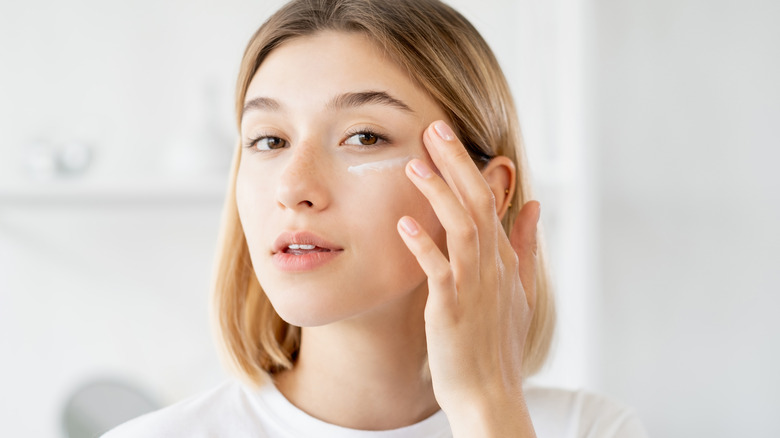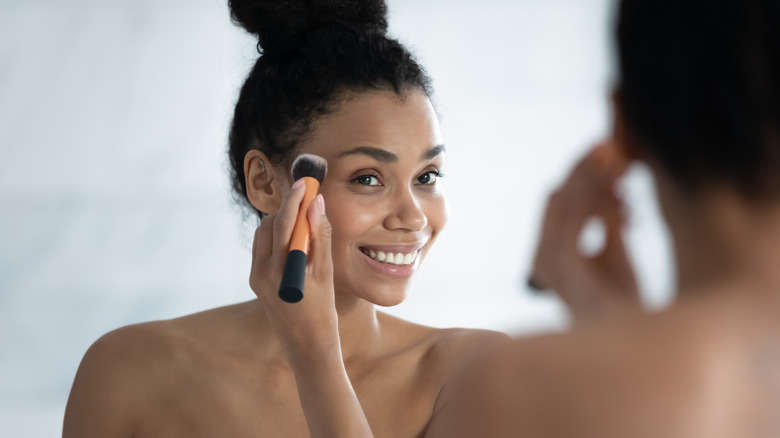Tips To Ensure Your Glass Skin Look Doesn't Veer Into Oily Territory
We may receive a commission on purchases made from links.
East Asia has blessed the beauty sphere with double cleansing, sheet masks, and gua sha facial tools, but arguably one of the most popular trends to come from the region is glass skin. According to Alicia Yoon, founder of Peach & Lily and K-beauty expert, smooth, glassy skin has long been the standard in South Korea, but the look only recently went global and earned the moniker "glass skin." "What's actually funny is glass skin wasn't really a thing in the U.S. and in Korea, where English isn't the primary language, the term 'glass' wasn't being used by Koreans," Yoon told Healthline. "What they say is a lot of words that describe glass. They'll say 'see-through.' They'll say 'bouncy skin,' 'clear skin,' or 'luminous skin.' There are just so many different ways to describe it."
No matter what you call it, glass skin should never be mistaken for oily skin. A glass skin complexion is radiant, with a moisturized finish that can sparkle like glass. However, the goal isn't to look greasy or slippery — a finish that might come a bit too easily to members of the oily skin squad. To achieve a glossy glow while keeping oil at bay, incorporate these tips into your skincare and makeup routine.
Work with your natural skin type
Glass skin can work for all skin types, though the route to getting there may look a little different. As Alicia Yoon shared with Healthline, there's a process to getting the dewy look: double cleanse, exfoliate, swipe on a pH-balancing toner, tap on an essence, add a layer of serum or face oil, and seal it all in with a moisturizer and SPF.
However, if your skin is naturally greasy, it helps to tweak the typical K-beauty routine. Curology, a brand of personalized skincare products, notes that oily and combination skin types require oil-free and non-comedogenic products that won't clog pores with heavy ingredients. That means that just because your favorite influencer promotes a certain face wash or cream doesn't mean it'll work for your skin. However, if you're choosing between a serum and an oil, don't fear the latter. Though face oils may seem heavy, Curology says they can keep sebum (your skin's natural oil) production under control.
For makeup, mattifying products may be the last thing you'd associate with glass skin, though makeup artist Cassandra Garcia recommends them for oily complexions. When it comes to getting glass skin, she told Coveteur, "Think about working with what you got and enhancing that natural sheen." If a glistening primer and luminous foundation are making you look sticky rather than silky, swap them for items better suited to your natural complexion.
Opt for lightweight moisture
Glass skin is all about showing off your luminous, moisturized glow, but you may need to rethink that tub of face cream sitting in your medicine cabinet. "In terms of consistencies, lotions and gels tend to dry faster and usually aren't as heavy as creams," Dr. Edidiong Kaminska, a board-certified dermatologist and fellow of the American Academy of Dermatology, explained to Today. Sure, heavy moisturizers can work wonders for dry skin (and during brutal winters), but lightweight varieties can help you achieve glass skin without leaving you looking shiny.
Keep in mind that moisturizer isn't the only source of moisture in a standard glass skin routine. "Layering is key here to achieving the extremely hydrated skin that's necessary for glass skin, so the 7 Skin Method — applying up to seven layers of toner to your skin — in general, works well for this," K-beauty and skincare expert Jude Chao revealed to Dermstore. That means there's no need to go for heavy-duty products; when layered and combined, your toner, face oil, moisturizer, and other hydrators work together to keep skin feeling fresh and nourished.
Apply highlighter strategically
Highlighting makeup is a must-have for amplifying a dewy, shine-like-a-diamond complexion. "I tell my clients to follow a K-Beauty-inspired skin-care routine and remix it by adding in your favorite highlighting products to create the perfect, glassy look," Sir John, a L'Oréal Paris celebrity makeup artist, shared with Makeup.com. But when it comes to applying these illuminators, less is usually more.
To enhance your luster with highlighting makeup without risking going overboard, makeup artist Beau Nelson told Coveteur, "You want the glow to be mostly applied on top of the cheekbones, inner corners of eyes, and the Cupid's bow of the lips. A little glow everywhere else should be taken care of by the type of skin prep and foundation you choose." Too much highlighter in the middle of the face can create an oily finish, especially if you already have a shiny T-zone to begin with.
Glow from the inside
If your face already has a surplus of sebum, drenching it in skincare products might only make you look as greasy as a cheese pizza. Though moisture is always essential, even for oily skin types (meaning you shouldn't skip your essences and moisturizing gel just yet!), don't overlook inside-out hydration. A 2015 study published in Clinical, Cosmetic and Investigational Dermatology found that when dehydrated people started drinking more water, the health and appearance of their skin improved. To find out if you have dehydrated oily skin, give yourself a pinch. "If you pinch the skin, it will remain tented because of lack of hydration," Dr. Hadley King, a board-certified dermatologist, told Prevention.
You can also eat your way to glowy, glassy skin, according to Healthline. Foods packed with healthy fats, like fatty fish and avocado, are powerhouses for your skin barrier. Antioxidant-rich fruits and vegetables may also boost your natural glow while protecting your skin from damaging free radicals. But if you're still battling an oil overload, watch out for foods that can rev up sebum production. These include dairy products, white bread, pasta, white rice, and sugary foods (per Medical News Today).




